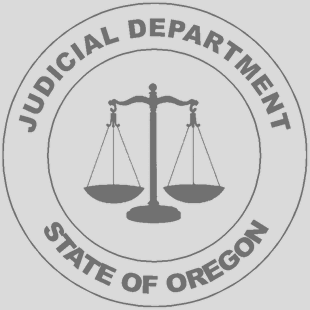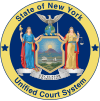In the United States, a state supreme court is the highest court in the state judiciary of a U.S. state. On matters of state law, the judgment of a state supreme court is considered final and binding in both state and federal courts.
In the United States, a state court has jurisdiction over disputes with some connection to a U.S. state. State courts handle the vast majority of civil and criminal cases in the United States; the United States federal courts are far smaller in terms of both personnel and caseload, and handle different types of cases. States often provide their trial courts with general jurisdiction and state trial courts regularly have concurrent jurisdiction with federal courts. Federal courts are courts of limited jurisdiction and their subject-matter jurisdiction arises only under federal law.
A county court is a court based in or with a jurisdiction covering one or more counties, which are administrative divisions within a country, not to be confused with the medieval system of county courts held by the high sheriff of each county.

The Appellate Division of the Supreme Court of the State of New York is the intermediate appellate court in New York State. The state is geographically divided into four judicial departments of the Appellate Division. The full title of each is, using the "Fourth Department" as an example, the "Supreme Court of the State of New York, Appellate Division, Fourth Judicial Department".
The Courts of England and Wales, supported administratively by His Majesty's Courts and Tribunals Service, are the civil and criminal courts responsible for the administration of justice in England and Wales.

The Civil Court of the City of New York is a civil court of the New York State Unified Court System in New York City that decides lawsuits involving claims for damages up to $25,000 and includes a small claims part for cases involving amounts up to $10,000 as well as a housing part for landlord-tenant matters, and also handles other civil matters referred by the New York Supreme Court. The court has divisions by county (borough), but it is a single citywide court.
The Superior Court is the state court in the U.S. state of New Jersey, with statewide trial and appellate jurisdiction. The New Jersey Constitution of 1947 establishes the power of the New Jersey courts. Under the State Constitution, "'judicial power shall be vested in a Supreme Court, a Superior Court, County Courts and inferior courts of limited jurisdiction.'" The Superior Court has three divisions: the Appellate Division is essentially an intermediate appellate court while the Law and Chancery Divisions function as trial courts. The State Constitution renders the New Jersey Superior Court, Appellate Division the intermediate appellate court, and "[a]ppeals may be taken to the Appellate Division of the Superior Court from the law and chancery divisions of the Superior Court and in such other causes as may be provided by law." Each division is in turn divided into various parts. "The trial divisions of the Superior Court are the principal trial courts of New Jersey. They are located within the State's various judicial geographic units, called 'vicinages,' R. 1:33-2(a), and are organized into two basic divisions: the Chancery Division and the Law Division".

The Oklahoma Court System is the judicial system for the U.S. State of Oklahoma. Based in Oklahoma City, the court system is a unified state court system that functions under the Chief Justice of Oklahoma who is its administrator-in-chief.

Superior courts in California are the state trial courts with general jurisdiction to hear and decide any civil or criminal action which is not specially designated to be heard in some other court or before a governmental agency. As mandated by the California Constitution, there is a superior court in each of the 58 counties in California. The superior courts also have appellate divisions which hear appeals from decisions in cases previously heard by inferior courts.
The Judiciary of Colorado is established and authorized by Article VI of the Colorado Constitution as well as the law of Colorado. The various courts include the Colorado Supreme Court, Colorado Court of Appeals, Colorado district courts, Colorado county courts, Colorado water courts, and municipal courts. The administration of the state judicial system is the responsibility of the Chief Justice of the Colorado Supreme Court as its executive head and is assisted by several other commissions. In Denver, the county and municipal courts are integrated and administratively separate from the state court system.
The New York Court of Chancery was the highest court in the State of New York from 1701 to 1847.

The Oregon Judicial Department (OJD) is the judicial branch of government of the state of Oregon in the United States. The chief executive of the branch is the Chief Justice of the Oregon Supreme Court. Oregon’s judiciary consists primarily of four different courts: the Oregon Supreme Court, the Oregon Tax Court, the Oregon Court of Appeals, and the Oregon circuit courts. Additionally, the OJD includes the Council on Court Procedures, the Oregon State Bar, Commission on Judicial Fitness and Disability, and the Public Defense Services Commission. Employees of the court are the largest non-union group among state workers.

The Judiciary of New York is the judicial branch of the Government of New York, comprising all the courts of the State of New York.

Courts of New York include:
The Judiciary of California or the Judicial Branch of California is defined under the California Constitution as holding the judicial power of the state of California which is vested in the Supreme Court, the Courts of Appeal and the Superior Courts. The judiciary has a hierarchical structure with the California Supreme Court at the top, California Courts of Appeal as the primary appellate courts, and the California Superior Courts as the primary trial courts.
The Florida State Courts System is the unified state court system of Florida.

Alfred Rider Page was an American lawyer, judge, and politician from New York.
In the U.S. state of New York, District Courts are state courts that are a type of trial court of inferior jurisdiction. District Courts are established in Nassau County and the five western towns in Suffolk County. Each contains individual districts for civil cases which are organized along town lines, while criminal cases are heard in a separate countywide or half-countywide district. They effectively replace town justice courts in these localities, but have subject-matter jurisdiction and operations similar to city courts.












